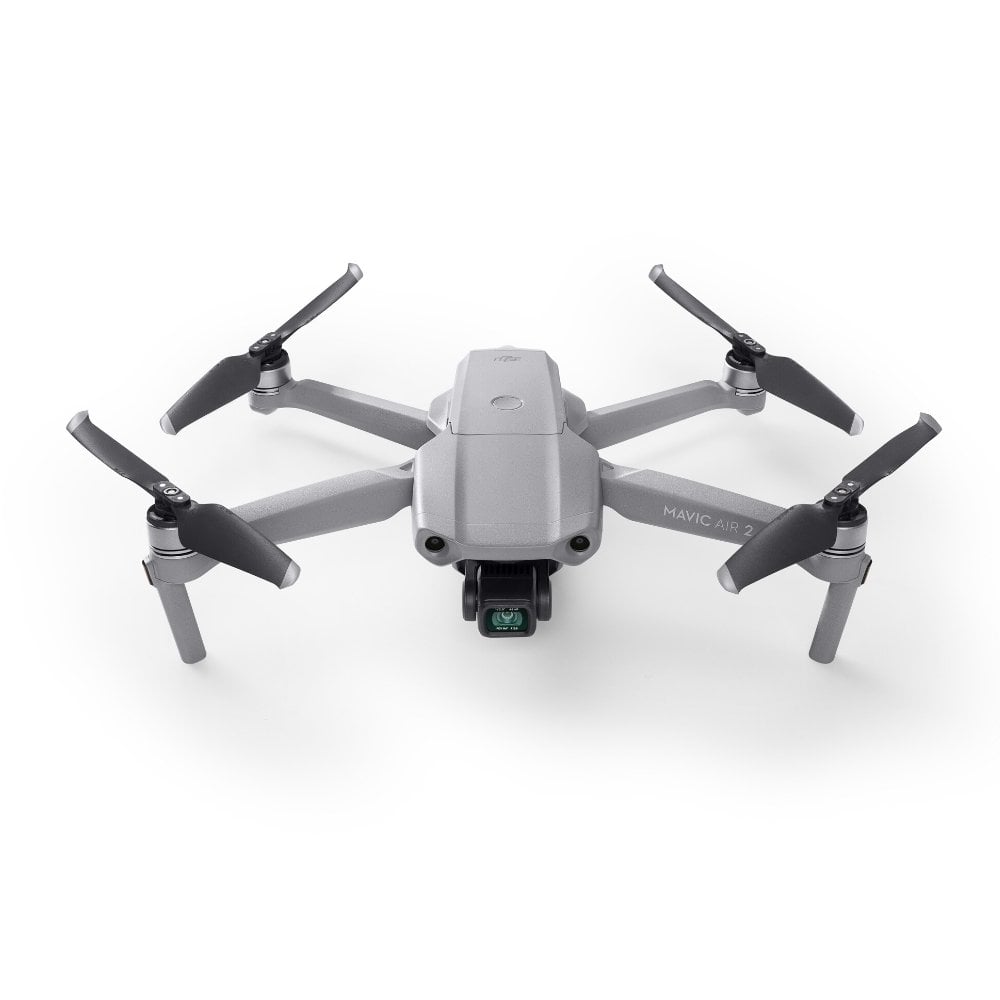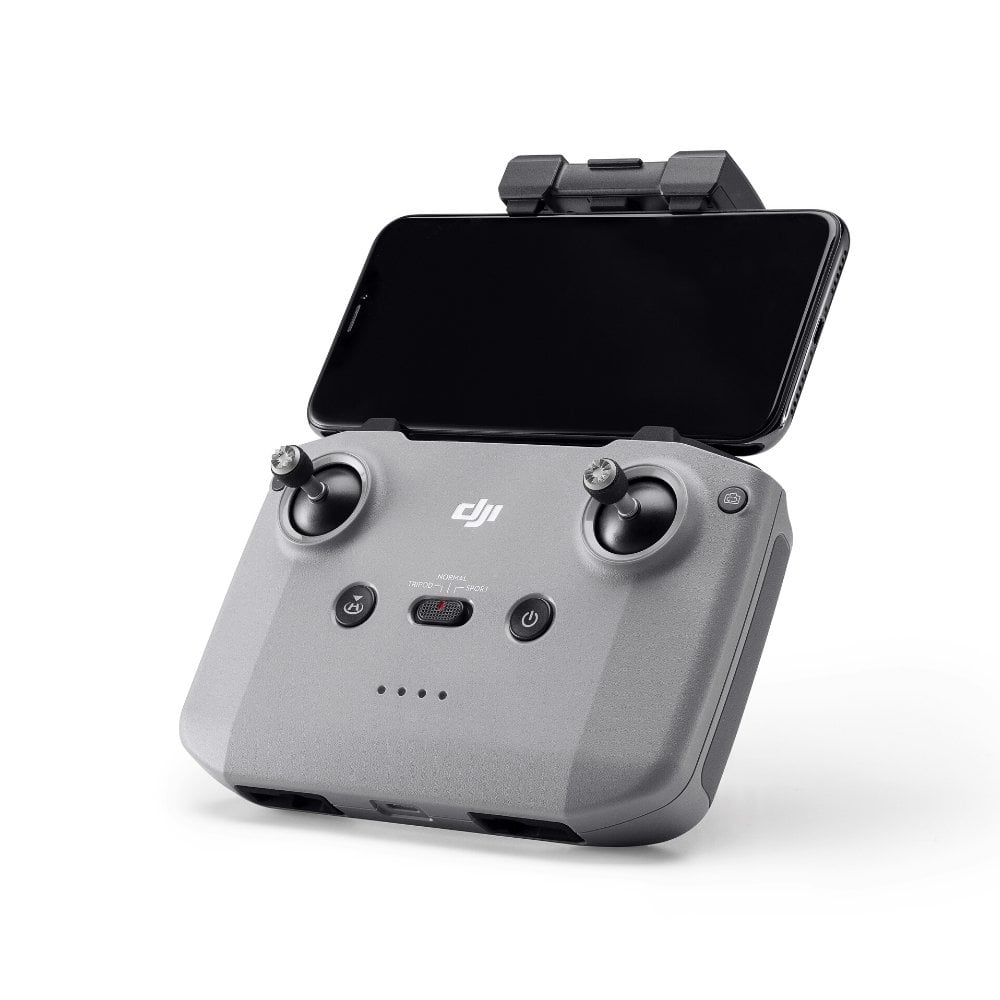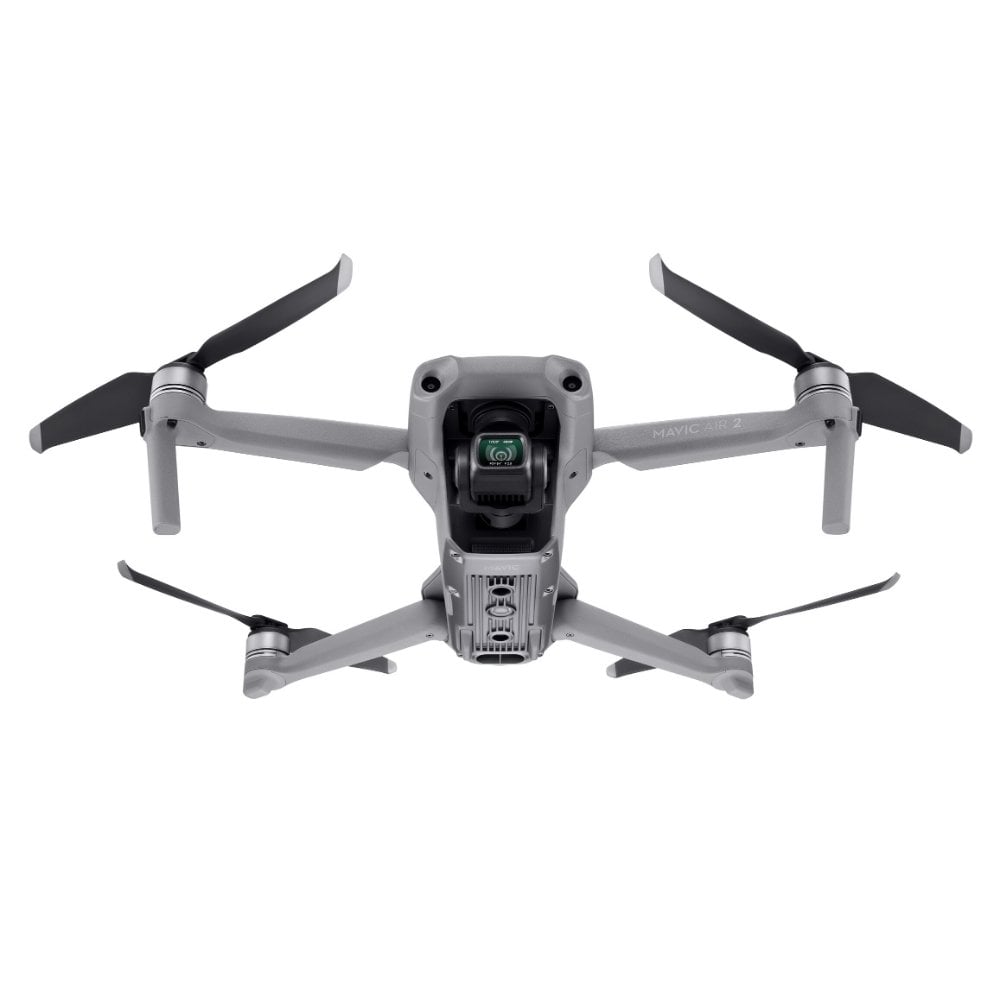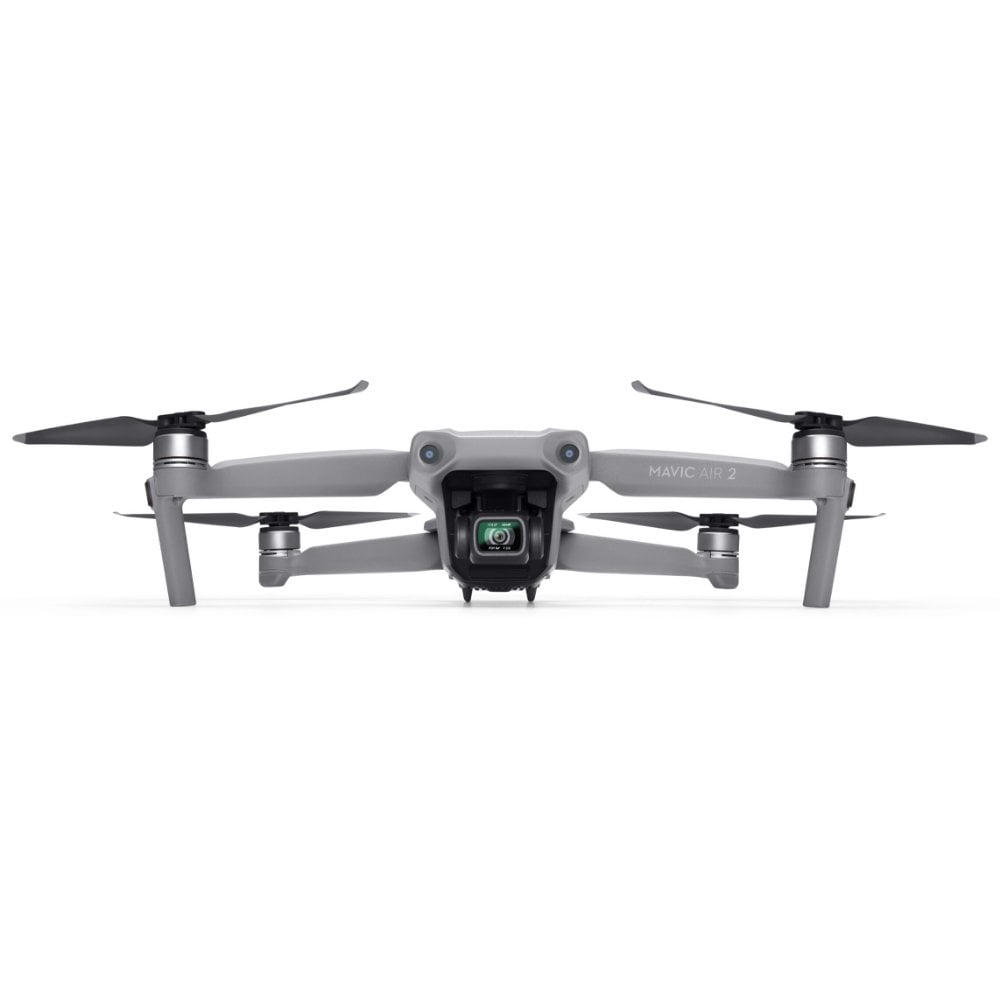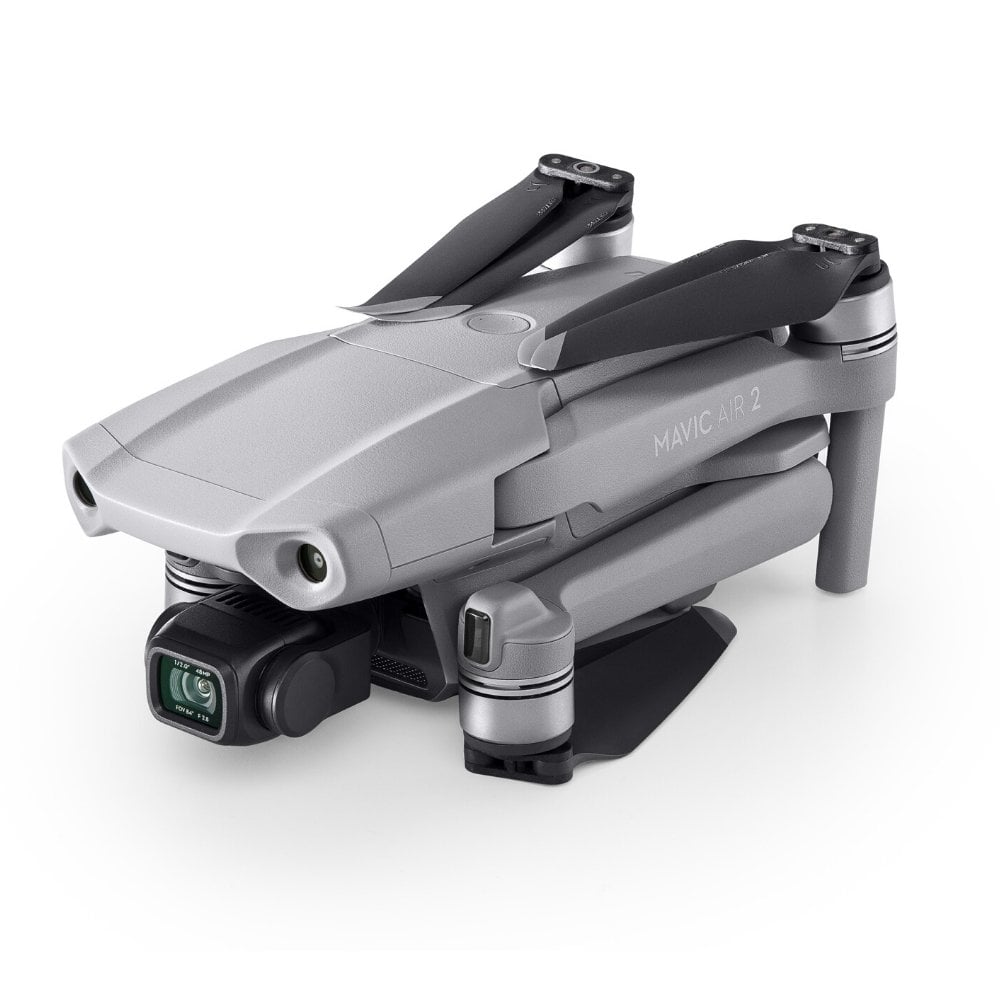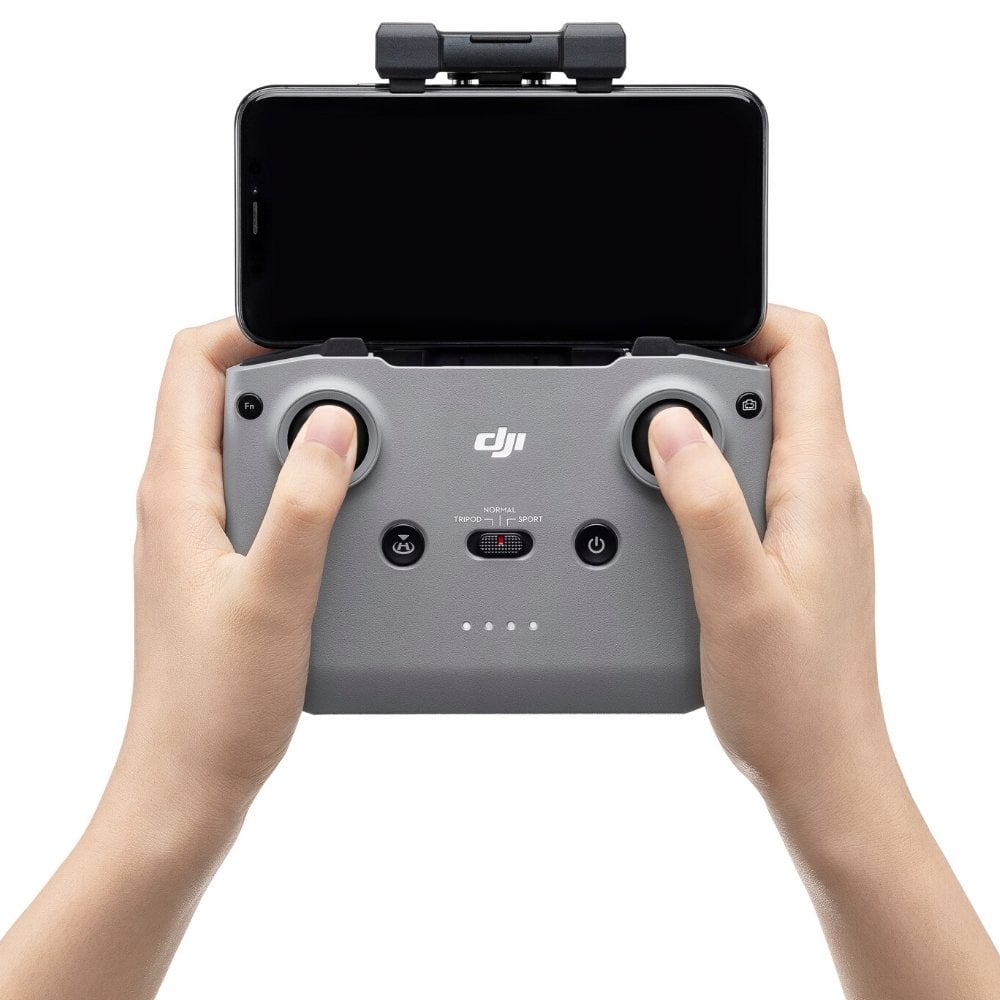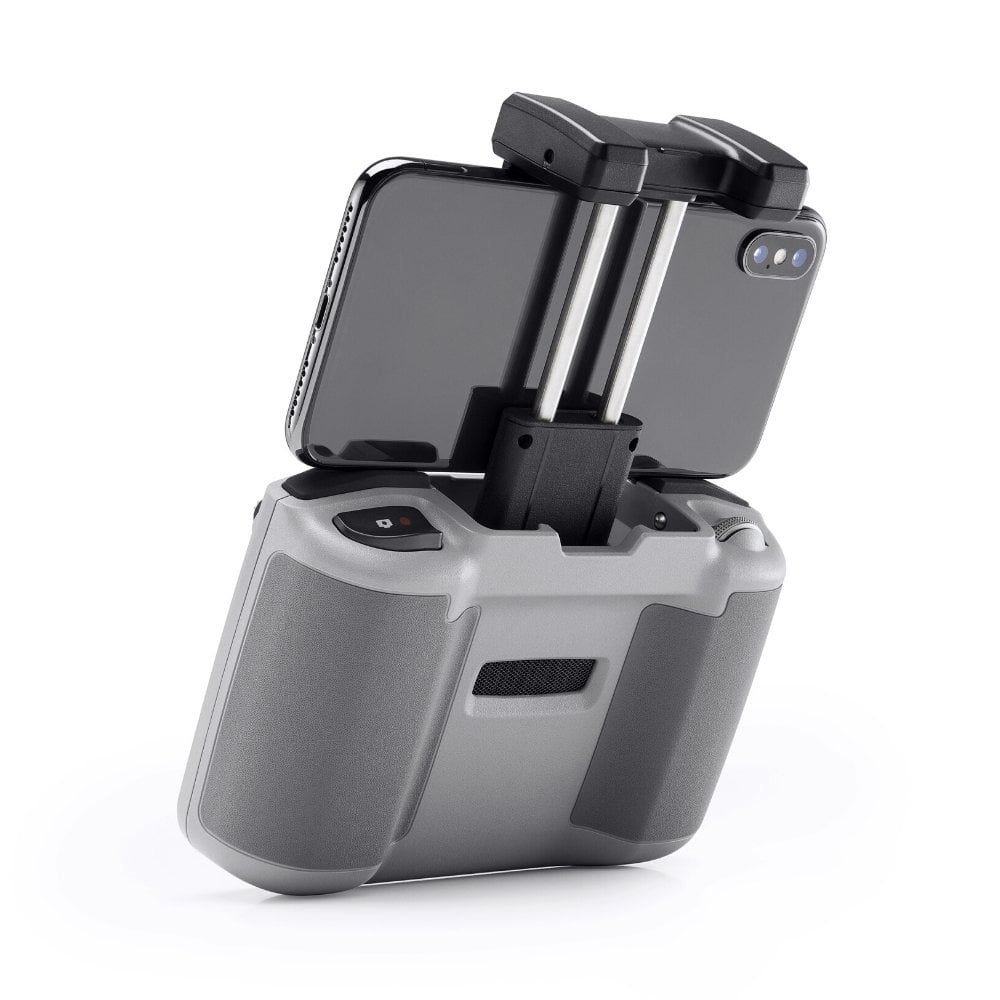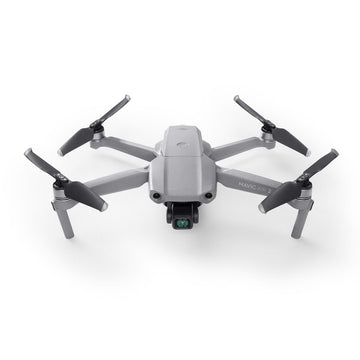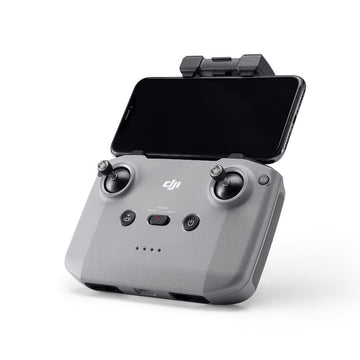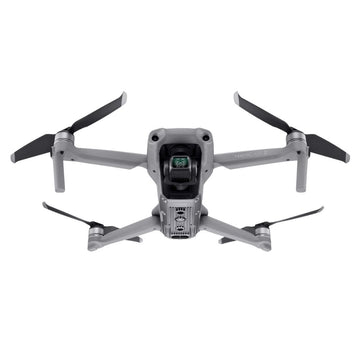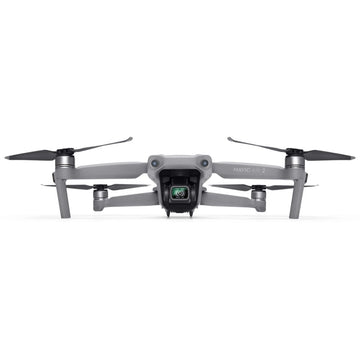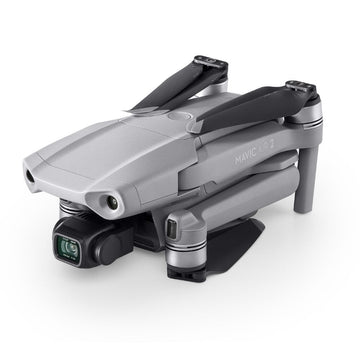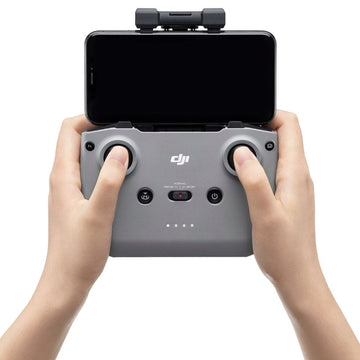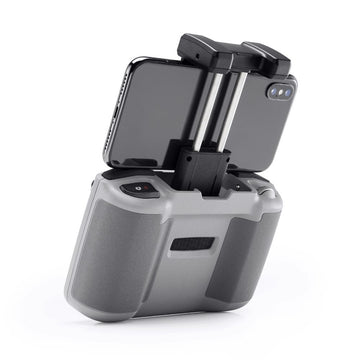Full Description
DJI Mavic Air 2
The perfect blend of power and portability with incredible smart features from DJI.

Key Features
- Camera - 48MP Photos, 4k/60fps Video
- Battery Life - 34 Minutes
- Weight - 570g
- Range - 10 km (FCC), 6 km (CE)
- Speed - 68km/h (18.9m/s)
- Active Track - Active Track 3.0
- App - DJI Fly App
Mavic Air 2 Camera Details
With a 1/2-inch CMOS sensor, the DJI Mavic Air 2 can capture stunning 48MP pictures. This impressive camera supports a high megapixel count that allows for vivid details, even when you zoom in on an image.
Capable of capturing effortlessly smooth 4K/60fps video.
The D-Cinelike flat colour profile retains more imaging information for post-processing.
The HEVC (H.265) video ensures next-level content.
Thanks to the Quad Bayer image sensor, the Mavic 2 Air can shoot incredible HDR video, yielding higher dynamic range and colour sensitivity.
And this new drone offers DJI's most advanced panorama mode.
Take stable shots thanks to the enhanced three-axis gimbal stabilisation.


Flight Modes with DJI Mavic Air 2
This drone, when flown with the DJI Fly App, boasts a suite of intelligent shooting modes through FocusTrack to help you unleash your creativity easier than ever before. These options are:
Spotlight 2.0: Fly freely while the camera remains locked on the subject with this convenient mode. Simply select your subject and fly.
ActiveTrack 3.0: Following subjects while avoiding obstacles is smoother than ever with the latest version of DJI’s ActiveTrack technology. With better pathfinding and a faster and more accurate prediction of lost subjects, this technology keeps your subject in the centre of the frame, even if they move behind a tree.
POI 3.0: POI 3.0 improves the capabilities of POI 2.0, especially the recognition of flat surfaces. Where POI 2.0 might lose the target while tracking, this improved feature does not. POI 3.0 is now also able to dynamically track objects like people, cars, and boats.
8K Hyperlapse: Allows you to warp time and space for incredible footage. Choose between various modes, select your shooting spot, and the Fly app will do the rest. Please note that 8K resolution can currently only be used in Free and Waypoint modes.
QuickShots: Capture incredible content, quickly and easily, thanks to QuickShots. QuickShots includes Dronie, Circle, Helix, Rocket, Boomerang and Asteroid. With just a few taps of the button, the drone plans and flies its aerial route for a quality shot, made simple.
OcuSync 2.0 Transmission
DJI Mavic Air 2 benefits from OcuSync 2.0, giving a video transmission distance of up to 10km and delivering a 1080p FHD resolution live stream directly from the drone's camera (FCC-compliant).
It supports 2.4/5.8GHz dual-frequency communication and automatically switches to the best channel with the lowest interference in real time. This significantly improves the aircraft's anti-interference ability in challenging environments.
APAS Collision Avoidance
Safety Features on DJI Mavic Air 2
To enhance flight safety, Mavic Air 2 benefits from three-way directional sensing (forward, backward, and downward). The drone has an auxiliary light to improve visibility, assist with positioning, and help with a safe landing.
For an added layer of safety, Mavic 2 Air has Advanced Pilot Assistance Systems (APAS) 3.0. This uses advanced mapping technology for reliable obstacle avoidance in complex scenarios.
This drone benefits from an impressive 34 minutes of flight time and can achieve a maximum flight speed of 68kph (in Sport mode).


DJI Fly App
The Fly app makes creating flawless videos more convenient than ever. The built-in DJI Mimo app editor provides manual settings, advanced functions, and intuitive templates, allowing you to create professional compositions in seconds.
Remote Controller
Operate your drone with a new remote controller, which benefits from a long battery life of 240 minutes. This newly-designed controller has an ergonomic design for a more comfortable grip. The new clamp makes attaching smartphones fast and easy, while integrated antennas significantly improve user experience.


Compatible With DJI Smart Controller
A firmware update has allowed pilots to fly the Mavic Air 2 with the DJI Smart Controller to optimise their flying experience.
There are many benefits of using the Smart Controller. These include:
- Built-in 5.5-inch 1080p screen; ultra-bright display, even in direct sunlight.
- At 1000 cd/m2, display is approximately 2x as bright as conventional smart device screens.
- -20°C to 40°C operating temperature.
- DJI Smart Controller connects to your drone as soon as it's powered for fast deployment.
- Integrated design with detachable control sticks makes the Smart Controller a portable option.
- OcuSync 2.0 Full-HD video transmission.
Frequently Asked Questions
Answers to your most common queries.
The camera performance, intelligent features, flight time, and transmission system have all improved significantly, and the new DJI Fly app provides an even more streamlined flying experience.
Yes. Read more about the DJI Smart Controller update which has allowed compatibility with the Mavic Air 2.
Attach the propellers with the white markings to the motors with white markings. Next, attach the propellers without markings to the motors without marking. Ensure the propellers are attached correctly, or the aircraft will not be able to take off.
SanDisk Extreme PRO 64GB UHS-III V30 A2 microSDXC
SanDisk High Endurance 64GB UHS-III V30 microSDXC
SanDisk Extreme 64GB UHS-III V30 A2 microSDXC
SanDisk Extreme 128GB UHS-III V30 A2 microSDXC
SanDisk Extreme 256GB UHS-III V30 A2 microSDXC
Lexar 667x 64GB UHS-III V30 A2 microSDXC
Lexar High-Endurance 64GB UHS-III V30 microSDXC
Samsung EVO Plus (Yellow) 64GB UHS-III microSDXC
Samsung EVO Plus (Red) 64GB UHS-III microSDXC
Samsung EVO Plus 128GB UHS-III microSDXC
Samsung EVO Plus 256GB UHS-III microSDXC
Kingston V30 128GB UHS-III microSDXC
Netac 256GB UHS-III A1 microSDXC
Yes. It has an auxiliary light for improved vision and safety in low light conditions, similar to the Mavic 2 series.
No. It provides forward, backward, and downward obstacle sensing.
APAS 3.0 has been dramatically improved compared to previous generations. The system generates a real-time map of its surroundings and currently offers the best obstacle avoidance available on a DJI aircraft.
Integrating the APAS 3.0 obstacle avoidance system, ActiveTrack 3.0 has been greatly improved compared to ActiveTrack 2.0. Overall tracking capabilities have improved greatly and re-establishing tracking after the subject has been lost is faster than ever, all while actively avoiding obstacles.
OcuSync 2.0 supports both 2.4 GHz and 5.8 GHz frequency bands. It features stronger interference resistance due to automatic frequency switching, delivering 1080p video transmission feeds at up to 10 km (when unobstructed, free of interference, and FCC-compliant).
The smartphone clamp of the remote controller houses the antennas. Make sure that the antennas are pointed toward the aircraft. Check the user manual for more information about setting the antenna direction. Additionally, ensure you are not wearing any transmitting wearables, and that Wi-Fi and Bluetooth are turned off on your mobile devices.
The remote controller boasts a prolonged battery life of up to 240 minutes, a more comfortable grip, an improved antenna design, and a more convenient line of sight when looking from screen to drone.
Normal photos can be taken in 12MP or 48MP, and RAW format is also available for more advanced editing.
Mavic Air 2 supports normal video at up to 4K/60fps and HDR video at up to 4K/30fps. Slow-motion videos are available in 1080p with up to 240 fps (8x slow-motion).
The camera offers D-Cinelike as a flat color profile.
The HEVC (H.265) is a more modern video codec than H.264; it retains more details and uses less storage space.
SmartPhoto integrates scene recognition, HyperLight, and HDR into one mode for optimal results. Scene recognition optimises different camera parameters for different scenes and supports intelligent recognition of five categories: sunset, blue sky, grass, snow, and green trees. Hyperlight optimises photos taken at night or in low-light situations. HDR selects the best image from multiple layers thanks to an adaptive dynamic expansion algorithm that determines optimal parameters.
8K resolution can only be used in Free and Waypoint modes.
FocusTrack consists of three different intelligent tracking modes, ActiveTrack 3.0, Point of Interest 3.0 (POI), and Spotlight 2.0. All three modes offer different tracking features for any situation.
QuickShot, Hyperlapse, and FocusTrack.
APAS 3.0 and FocusTrack are not available while recording in 4K at 60, 50, and 48 fps, 2.7K at 60, 50, and 48 fps, and 1080p at 120 and 240 fps.
Yes it does, it is the first consumer drone designed to include AirSense technology, which provides enhanced safety by warning drone pilots of other aircraft nearby. However, the Mavic Air 2 units equipped with AirSense/ADS-B will initially only be available in North America. A version of the drone is available outside of North America without ADS-B. The two models are identical in all other aspects, such as flight and imaging performance.
DJI has said that it is working towards making ADS-B-equipped Mavic Air 2 drones available globally and will update when this timing has been confirmed.
This depends where you live, as there are different rules in different countries. Here is what you need to know if you are operating this drone in the UK or US.
UK
You will need to register your Mavic Air 2 because it weighs over 250g. You can register the drone via the CAA (Civil Aviation Authority)'s Drone and Model Aircraft Registration and Education Service. There are three main requirements. These are:
- pass a free online test to get a flyer ID if you want to fly your Mavic Air 2 (valid for three years)
- register for an operator ID if you’re responsible for the Mavic Air 2
- label your Mavic Air 2 with your operator ID.
US
If you're a recreational drone pilot, you simply need to register your Mavic Air 2 with the FAA (Federal Aviation Administration), then mark your drone with the registration number.
If you are flying your drone for commercial purposes, you will need to register your drone when flying under Part 107 and label your drone with your registration number. Registration costs $5 per aircraft and is valid for 3 years.
You can either update the firmware over the DJI Fly app or Assistant 2 for Mavic desktop software (available for Mac and Windows). Both can be found on DJI's official homepage.
Use either the DJI Fly app or Assistant 2 for Mavic to update the firmware.
Can't find what you're looking for?
Buy Now Key Features Camera Details Range with OcuSync 2.0 Collision Avoidance DJI Fly App Updated Remote FAQsWatch the video review of the Mavic Air 2
Help & Advice
Product Specification
Mavic Air 2 Specs
Drone
|
Specification |
Value |
|---|---|
|
Weight |
570g |
|
Size |
Folded: 180×97×84mm (L×W×H). Unfolded: 183×253×77mm (L×Wx×H)
|
|
Diagonal Distance |
302mm |
|
Max Ascent Speed |
4m/s (S Mode); 4m/s (N Mode)
|
|
Max Descent Speed |
3 m/s (S Mode); 3 m/s (N Mode);
5 m/s (S Mode during a sharp descent);
3 m/s (all modes at elevations over 4500m)
|
|
Max Service Ceiling Above Sea Level |
5000m |
|
Max Flight Time (without wind) |
34 minutes |
|
Max Hover Time (without wind) |
33 minutes |
|
Max Flight Distance |
18.5km |
|
Max Horizontal Flight Speed |
19m/s (S Mode);
12 m/s (N Mode);
5 m/s (T Mode)
|
|
Max Wind Resistance |
8.5-10.5 m/s (Level 5) |
|
Max Tilt Angle |
35°(S Mode); 20°(N Mode);
35° under heavy winds
|
|
Max Angular Velocity |
250°/s (S Mode); 250°/s (N Mode)
|
|
Operating Temperature Range |
-10° to 40°C (14° to 104°F)
|
|
Operating Frequency |
2.400-2.4835 GHz; 5.725-5.850 GHz
|
|
Transmitter Power (EIRP) |
2.400-2.4835 GHz:
FCC: ≤26 dBm; CE: ≤20 dBm; SRRC: ≤20 dBm; MIC: ≤20 dBm
5.725-5.850 GHz:
FCC: ≤26 dBm; CE: ≤14 dBm; SRRC: ≤26 dBm.
|
|
Hovering Accuracy Range |
Vertical: ±0.1 m (with vision positioning) ±0.5 m (with GPS positioning)
Horizontal: ±0.1 m (with vision positioning) ±1.5 m (with GPS positioning)
|
|
Satellite Systems |
GPS+GLONASS |
|
Compass |
Single Compass |
|
IMU |
Single IMU |
|
Internal Storage |
8GB |
Battery
|
Specification |
Value |
|---|---|
|
Capacity |
3500 mAh |
|
Voltage |
11.55V |
|
Charging Voltage Limit |
13.2V |
|
Battery Type |
LiPo 3S |
|
Energy |
40.42 Wh |
|
Weight |
198g |
|
Charging Temperature |
5° to 40°C (41° to 104°F)
|
|
Max Charging Power |
38W |
Camera
|
Specification |
Value |
|---|---|
|
Sensor |
1/2" CMOS Effective Pixels: 12MP and 48MP
|
|
Lens |
FOV: 84°
Equivalent Focal Length: 24 mm
Aperture: f/2.8
Focus Range: 1 m to ∞
|
|
ISO |
Video: 100-6400
Photo (12 MP):
100-3200 (Auto),
100-6400 (Manual)
Photo (48 MP):
100-1600 (Auto),
100-3200 (Manual)
|
|
Max Photo Resolution |
48MP (8000×6000 pixels)
|
|
Photo Modes |
Single: 12 MP and 48 MP
Burst: 12 MP, 3/5/7 frames
Automatic Exposure Bracketing (AEB): 12MP, 3/5 Frames at 0.7EV Bias
Timed: 12 MP 2/3/5/7/10/15/20/30/60 seconds
SmartPhoto: Scene Recognition, HyperLight, and HDR
HDR Panorama:
Vertical (3×1): 3328×8000 pixels (Width×Height)
Wide (3×3): 8000×6144 pixels (Width×Height)
180° Panorama (3×7): 8192×3500 pixels (Width×Height)
Sphere (3×8+1): 8192×4096 pixels (Width×Height)
|
|
Photo Formats |
JPEG/DNG (RAW)
|
|
Video Resolution and Frame Rates |
4K Ultra HD: 3840×2160 24/25/30/48/50/60 fps
2.7K: 2688×1512 24/25/30/48/50/60 fps
FHD: 1920×1080 24/25/30/48/50/60/120/240 fps
4K Ultra HD HDR: 3840×2160 24/25/30 fps
2.7K HDR: 2688×1512 24/25/30 fps
FHD HDR: 1920×1080 24/25/30 fps
|
|
Colour Profiles |
D-Cinelike Normal
|
|
Video Formats |
MP4/MOV (H.264/MPEG-4 AVC, H.265/HEVC)
|
|
Max Bitrate |
120 Mbps |
|
Supported SD Cards |
Supports a microSD with capacity of up to 256GB |
|
Supported File Systems |
FAT32 and exFAT
|
|
Zoom |
Not available |
Gimbal
|
Specification |
Value |
|---|---|
|
Stabilisation |
3-axis (tilt, roll, pan)
|
|
Mechanical Range |
Tilt: -135° to 45°
Roll: -45° to 45°
Pan: -100° to 100°
|
|
Controllable Range |
Tilt:
-90° to 0°(Default)
-90° to 24°(Extended)
|
|
Max Controllable Speed (Tilt) |
100°/s |
|
Angular Vibration Range |
±0.01°
|
Vision System
|
Specification |
Value |
|---|---|
|
Forward |
Precision Measurement Range: 0.35-22.0 m
Detection Range: 0.35 to 44 m
Effective Sensing Speed: 12 m/s
Field of View (FOV): 71° (horizontal), 56° (vertical)
|
|
Backward |
Precision Measurement Range: 0.37-23.6 m
Detection Range: 0.37-47.2 m
Effective Sensing Speed: 12 m/s
Field of View (FOV): 44° (horizontal), 57° (vertical)
|
|
Available Downward Sensors |
Dual Vision Sensors + Time of Flight Sensors (ToF)
|
|
Downward |
ToF Measurement Range: 0.1-8m
Hovering Range: 0.5-30m
Vision Sensor Hovering Range: 0.5-60m
|
|
Left/Right |
None
|
|
Downward Auxiliary Light |
Single LED
|
Safety
|
Specification |
Value |
|---|---|
|
Obstacle Avoidance System |
Advanced Pilot Assistance Systems (APAS) 3.0
|
Video Transmission
|
Specification |
Value |
|---|---|
|
Transmission System |
OcuSync 2.0 - 2.4 GHz/5.8 GHz Auto-Switching
|
|
Max Transmission Distance |
10km (FCC),
6km (CE),
6km (SRRC),
6km (MIC)
|
|
Live View Quality |
720p@30fps / 1080@p30fps
|
|
Latency (depending on conditions)
|
120-130ms
|
|
Video Transmission Encoding format |
H.265
|
|
Max Live View Bitrate |
40Mbps
|
|
Operating Frequency |
2.400-2.4835GHz;
5.725-5.850 GHz
|
Remote Controller
|
Specification |
Value |
|---|---|
|
Remote Controller Transmission System |
OcuSync 2.0
|
|
Supported Mobile Device Connectors |
Lightning,
Micro USB,
USB Type-C
|
|
Max. Supported Mobile Device Size |
180×86×10 mm
(Height×Width×Thickness)
|
|
Operating Temperature |
-10° to 40°C
(14° to 104°F)
|
|
Transmitter Power (EIRP) |
2.400-2.4835 GHz:
FCC: ≤26 dBm
CE: ≤20 dBm
SRRC: ≤20 dBm
MIC: ≤20 dBm
5.725-5.850 GHz:
FCC: ≤26 dBm
CE: ≤14 dBm
SRRC: ≤26 dBm
|
|
Operating Current/Voltage |
1200 mA@3.7V (Android)
700 mA@ 3.7 V (iOS) |
Charger
|
Specification |
Value |
|---|---|
|
Charging Input |
100-240 V, 50/60 Hz, 1.3 A
|
|
Charging Output |
Charging Port: 13.2 V⎓2.82 A
USB Port: 5 V⎓2 A
|
|
Voltage |
13.2V
|
|
Rated Power |
38W
|
What's in the Box
Remote Controller x 1
Battery x 1
Low Noise Propellers (pair) x 3
RC Cable (USB Type-C Connector) x 1
RC Cable (Lightning Connector) x 1
RC Cable (Standard Micro-USB Connector) x 1
Control Stick x 1
Gimbal Protector x 1
Battery Charger x 1
AC Power Cable x 1
Type-C Cable x 1
